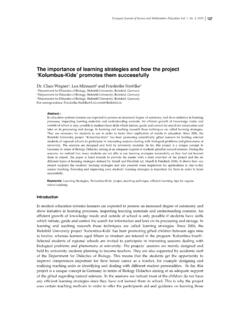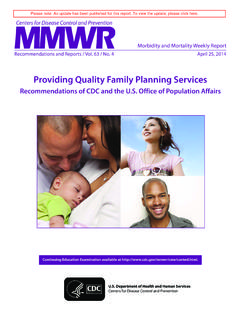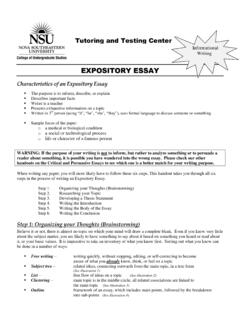Transcription of Program Planning and Implementation Slides
1 Worksite Health 101. Program Planning and Implementation Making the Leadership and Planning & Program Culture Data Collection Implementation Evaluation Business Case Relationship between Driving senior Worksite health Determining Program Measuring process health and leadership support assessment process goals and objectives and Impact of performance outcomes Creating a healthy Types of data to Developing detailed worksite worksite culture collect Key evaluation health Program worksite health plans metrics Building infrastructure Data for Program and capacity Putting assessment Key components of a Planning and Planning into comprehensive worksite practice health Program Module 1 Module 2 Module 3 Module 4 Module 5. 2. 85. Learning Objectives Understand the following: The importance of Program Planning in a comprehensive approach to worksite health.
2 Using data to develop a detailed worksite health plan. How to write objectives that drive effective Program Implementation . How to set reasonable objectives for behavior change. Three year strategic Planning process. 3. Worksite Health Planning In this section: The value of Program Planning . Program Planning as part of a comprehensive worksite health Program . Developing a detailed worksite health improvement plan. Setting realistic behavior change expectations. 4. 86. The Value of Program Planning Written worksite health improvement plans allow employers to: Focus on priorities. Link worksite health to the business plan and strategic objectives. Formalize efforts. Set expectations and timelines. Define roles and responsibilities. Measure impact and validate programs.
3 Provide continuity through change. 5. CDC Workplace Health Model Individual Organizational Community ( , demographics, health ( , current practices, work ( , transportation, food and Assessment risks, use of services) environment, infrastructure) retail, parks and recreation). Environmental Programs Policies Health Support Planning / ( , education ( , organizational Benefits ( , access, Implementation and counseling) rules) ( , insurance, opportunity, incentives) physical/social). Worker Healthcare Improved Health Organizational Change Productivity Costs Outcomes Culture of Health . Evaluation ( , absenteeism, ( , quality of care, ( , reduced disease ( , morale, recruitment/retention, presenteeism) performance and disability) alignment of health and business standards) objectives).
4 Workplace Governance ( , leadership support, dedicated resources, health improvement plan, staffing, partners/vendors, communications, informatics). Contextual Factors 6 ( , company size, company sector, capacity, geography). 87. Planning and Implementation The process of selecting science and practice based interventions to create a healthy culture to support individual healthy lifestyle choices. Identifies key areas of needs and interest based on data assessment results. Includes programs, policies, environmental supports and health benefit design. Supports outcomes evaluation. Aligns resources and infrastructure. 7. Worksite Health Improvement Planning How to Write a Good Worksite Health Improvement Plan Worksite Health Mission Statement Describes your Program focus in one or two sentences.
5 Aligns with and should be an integral part of your overall your corporate strategy. Sample Mission: At Bean (Freeport, ME). o The mission of the Employee Health Program is to work with area management and employees to achieve and maintain a healthy and safe workplace, and promote the health, safety and fitness of employees. 8. 88. Writing the Worksite Health Improvement Plan The Worksite Health Improvement Plan should address primary health concerns identified through data collection and assessment First: Identify WHO you are targeting in the objective. Second: Identify WHAT you want the target group to do. Third: Identify HOW MUCH you want the behavior to change. Fourth: Identify WHEN you want to see the behavior change happen. 9. Writing the Worksite Health Improvement Plan Worksite Plan Objectives WHO.
6 Is your target . o Employees o Management o Spouses o 3rd shift 10. 89. Writing the Worksite Health Improvement Plan Worksite Plan Objectives WHAT. Let your data decide What do you want your target group to do? What action(s) do you want them to take? o Increase physical activity o Decrease overweight/obesity o Decrease tobacco use 11. Writing the Worksite Health Improvement Plan Worksite Plan Objectives HOW MUCH. How much do you want the behavior/outcome to change? o Increase/decrease your baseline measurement From % to %. From 10 people to 20. At least 30%. No more than 10%. 12. 90. Writing the Worksite Health Improvement Plan Worksite Plan Objectives WHEN. Set a specific date o Typically a 12 month calendar o May be reasonable to set a longer date up to two years Example: It is now January, but your new pharmacy benefit plan that includes nicotine replacement therapy (NRT) does not begin until June.
7 It is reasonable to work 12 months out from June and set an 18 month time frame to give your employees a full year to quit using tobacco. 13. Writing the Worksite Health Improvement Plan What is wrong with this objective? Increase participation in the health assessment. 14. 91. Worksite Health Planning Process Increase participation in the health assessment: Who ? What Increase participation in the health assessment How Much ? By When ? 15. Worksite Health Planning Process Objective Who Employees and spouses What Increase participation in the health assessment How Much From 30% to 50% of employees and spouses By When By 12/31/2015. 16. 92. Health Improvement Planning Process OBJECTIVE DATE Program PROCESS RESPONSIBLE EVALUATION. (What?) (When?) (What?) (How?)
8 PARTY (Who? What? By When?). 70% or more of By Conduct free Outside vendor Tom Smith # of our employees 1/5/13 health to distribute and ABC participants will complete the assessment for collect HA at Consulting health all employees. employee Satisfaction . assessment (HA) meetings survey by 1/5/13. between shifts. Aggregate data At least 90% of By Healthy Heart Healthy cooking Jane Doe to Pre & Post . employees with at 2/2/13 campaign demonstration identify knowledge least one cardiac during Heart and health American survey risk factor will Month education Heart increase their activity for all Association Satisfaction knowledge of shifts on meal resource to Survey preventing break. come onsite. cardiovascular disease by 2/2/13. 17. Action Planning Further detailed Planning for activities to support the worksite health improvement plan goals and objectives o Roles and responsibilities for team members o Timeline for each activity o Resources needed (financial/nonfinancial).
9 O Communication strategies o Data sources/Evaluation strategies 18. 93. Setting Reasonable Expectations Creating a healthy worksite culture and changing individual behaviors takes time Expectations should be based on several factors: o Difficulty (ex: increasing the percentage of people who know their cholesterol numbers is much easier than losing weight or quitting smoking). o Financial resources dedicated to the worksite health initiative o Policies/environmental changes to support behavior change o Benefit plan design and incentive plan o Personnel necessary to develop and maintain the Program 19. Planning Effective Interventions In this section: Program strategies and interventions Types of worksite health interventions Intervention examples 20. 94. Worksite Health Interventions Areas for consideration: Driven by data collection and assessment Address most common or costly health risk or lifestyle factors Employee interests Budget/Time constraints Management expectations for the worksite health Program Effective and science based 21.
10 Program ProgramStrategies Strategies and and Interventions Interventions 95. Types of Worksite Health Interventions Support for individual health behaviors Programs Individual health coaching/counseling; health classes Formal or informal statements to protect Policies employee health Tobacco free campus; healthy food policies Environmental Physical factors that foster healthy choices Supports Stairwell enhancement; walking paths Health Plan Strategy to impact key risks and cost drivers by Design influencing behavior change 23. Multiple Strategies are Most Effective Comprehensive worksite health programs should strive to: Use multiple interventions, such as combining a policy and a health benefit strategy, for a single health issue. o Combinations are more effective than any one intervention alone.














